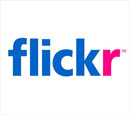At a Glance
What is it?
Website
Flickr

Flickr is an online photo management and sharing application. It allows you to upload photos and share, edit, organize, and geotag them, as well as create your own galleries and develop image-based projects. Flickr Commons, a Flickr subgroup, provides access to publicly-held photography collections of museums, archives, and art galleries around the world for public use and comment. Helping students understand the various licenses under Creative Commons is an excellent way to foster discussions on copyright issues—helpful as students progress to college.
Flickr, then, is a valuable resource for educators as they teach subject area content, digital literacy, critical thinking skills, and ideas such as "intellectual property."
Getting Started
Signing in to Flickr is easy. You can use either create a Yahoo account to create a user name and ID, or sign in with a Facebook or Google account. The Flickr Tour offers clear instructions for uploading, editing, organizing, and sharing photos as well as for integrating Flickr with mapping tools and for using it to create projects. Users can also stay up to date with the latest developments via the Flickr blog. Also, for a quick fix on the Flick search function, check out Find Pictures with Flickr on YouTube, a one-and-a-half minute video. Flickr Tutorial Basic Tools, also a YouTube video (it's about seven-and-a-half minutes long), gives more detailed examples of basic Flickr processes you'll need for the classroom: advanced search, Creative Commons, uploading and downloading, how to add notes, and how to create photo sets.
Examples
One of the best uses for Flickr in the history classroom is the gallery feature: a "curator" experience that allows users to comb through Flickr's millions of photos in order to create a photo collection. In addition, users can collect images across the internet, upload them into Flickr, then use those photos in the creation of the gallery. Regardless, curating a photo exhibit is an excellent opportunity to work with students on photo selection. Educators can also pose questions that encourage students to asses their own thinking: Why choose this photo, and not that one? Why settle on 10 pictures and not five, or 15? Did you use images that are in the public domain, or copyrighted? Does it matter if you find out that this photo was staged?
Raising questions about intellectual property and copyright with students—particularly the history and court cases related to these topics—is a very useful discussion as they prepare to enter careers or further their education on a college campus. Discussing photo selections can also greatly enhance the teaching and learning of history by forcing students to pay attention to the details of an image, and perhaps to investigate its origin in order to contextualize it. In this quickly constructed gallery of U.S. Presidents, a simple question asks "What do these official, and unofficial, portraits of 10 U.S. Presidents reveal to us about American society?" Here, teachers can construct a gallery and model for students two concepts: photo selection and inquiry-based learning through visuals. Attached to some pictures are some leading comments or directions that can further students' own thoughts as they tackle the main question at hand. In the comments section at the end of the gallery, students can post their response to the question (Note: To post comments, students would have to login ti Flickr using their Google or Yahoo account.) Teachers would probably be wise to think about ways to avoid repetitive answers, such as allowing students to pick a few of the pictures, creating two smaller galleries to split among students, or simply by creating alternate questions for student groups. After modeling and discussing a particular gallery, teachers can then assign each student to curate their own gallery, provide information per image, and ask students to leave comments on each other's products. The "student-as-a-museum-tour guide" approach is an excellent exercise that stimulates higher-order thinking, creates dialogue, and can deepen historical understanding.
For more information
Another good collection of sites for visual literacy is found at JakesOnline.
More information on Visual Teaching Strategies can be found here
Explore more on the Flickr Educators Discussion Page
There are also plenty of other ideas that can be incorporated into the history classroom from other disciplines. And for more on copyright and photographs, try our blog entry and Ask a Digital Historian on the subject.